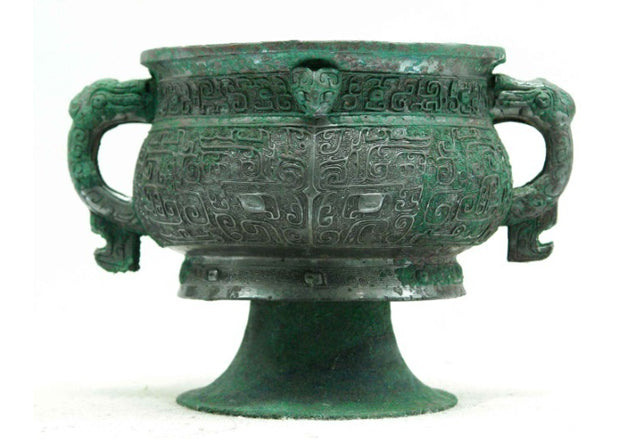
Zaobo Gui

The Zaobo Gui is a bronze food container from the early Western Zhou Dynasty. It is 16.5 cm tall, 24 cm wide including the ears, 17 cm in diameter, 6.3 cm high on the stand, 13.4 cm in diameter on the stand bottom, weighs 2.15 kg, and has a capacity of 1.7 liters. It was unearthed from Tomb 242 of the Ying State Cemetery in Fuyangling, Pingdingshan City, Henan Province in 1993.
The Zhabo Gui has a round open mouth, a slanted square lip, a short neck with a shallow belly, a bulging belly that is slightly drooping, and a pair of dragon-head-shaped ears on the belly. The upper end of the ears is located on the neck, and the lower end is located on the lower abdomen. The ears are drooping, and the short ring foot is slightly outward, with a trumpet-shaped stand attached inside. The neck is decorated with two groups of eight Kuilong patterns with fine thunder patterns as the ground pattern. Each group of four Kuilong patterns is centered on a relief animal head and is arranged on both sides. The Kuilong patterns on the same side follow each other in front and behind, and all have animal heads. The abdomen is decorated with two groups of convex-eyed animal face patterns with fine thunder patterns as the ground pattern, and two symmetrical Kuilong patterns are placed on the left and right sides of each group of patterns. The upper end of the ear is decorated with a dragon head, and the lower two sides are decorated with negative line "C"-shaped rolling cloud patterns. The whole ear is in the shape of a dragon mouth with a long tongue sticking out and bending inward. The ring foot is decorated with convex-eyed oblique cloud patterns, and the trumpet-shaped support is plain (Figure 1, Figure 2).
Figure 1 Line drawing of the Zhabo Gui

Figure 2 Rubbing of the decoration (partial) of the Zhabo Gui
The rust color of the gui body and the support is very different because the texture of the copper material of the gui body and the support is quite different. The excavators speculated that the bronze gui was pre-cast into a trumpet-shaped support, or it could be made by cutting off the ring foot of a bronze goblet (a kind of wine vessel), and then using some kind of process to cast it into one piece with the gui body. The connection between the two is reinforced by four obvious four-petal flower-shaped convex nails.
There are 8 lines of 74 characters inscribed on the bottom of the Zaobo Gui, indicating that the maker was Zaobo, hence the name Zaobo Gui. Inscription on the bottom of the Gui (Figure 3)
Figure 3 Inscription and rubbings on the bottom of the "Zaobo" Gui
The inscription roughly says that on the morning of the Gengshen day of August, the King of Zhou held a grand archery ceremony in the capital Haojing. The participants in the competition were divided into two groups: the King of Zhou ordered Nangong to lead the princes and the younger brothers who were awarded the title, and the master led the king's ministers. The King of Zhou took out ten red copper plates as prizes. The King of Zhou said: "Boys and ministers, you must compete cautiously and humbly. Those who hit more targets can get these ten red copper plates." As a result, Zaobo hit all ten targets, and the King of Zhou gave him the prize and also gave him two other musical instruments. To commemorate this honor, Zabo used the red copper gifted by the King of Zhou as raw material to cast a bronze gui for offering sacrifices to Duke Zhou[2].
The Zabo gui has a unique shape, with an open mouth, rolled edges, narrow neck, drooping belly, oblique straight low ring foot and a trumpet-shaped support. It is unique among the bronze gui discovered in the Shang and Zhou dynasties. The gui is finely made, and the decorative patterns are well arranged, symmetrical and solemn. The main body is a slender convex line, and the background is a thin thunder pattern as thin as a hair. The lines are natural and smooth, light and elegant. The inscription font is beautiful but not weak, and the layout is compact but not restrained. It can be regarded as a rare early calligraphy.
The inscription on the Zabo gui is a very good narrative. In just 74 words, it explains the time, place, participants, events and ending of the "Great Shooting Ceremony". It is concise, well-structured and orderly. More importantly, it provides extremely valuable information for the study of my country's ancient archery ceremony system.


![8.3"China Shang Dynasty,Bronze wine cup [Fuhao Jue cup][妇好爵杯]](http://bronzc.com/cdn/shop/files/4ee0482982cfa89bb4d1cff3333a55e6_e3ca0b86-22fc-497d-9afd-578c551225a3-2.jpg?v=1733986652&width=533)

![12.8" China Ming Dynasty, Phoenix-patterned bronze vase[Ming Wanli Phoenix-patterned vase][明万历凤纹瓶]](http://bronzc.com/cdn/shop/files/4ee0482982cfa89bb4d1cff3333a55e6_a516991b-2bb9-4b2f-a2b6-4354129d006c.jpg?v=1733986953&width=533)

![14.6" China Eastern Han Dynasty Bronze vessel in the shape of a flying horse,Also known as bronze galloping horse[Horse Stepping on Flying Swallow][马踏飞燕]](http://bronzc.com/cdn/shop/files/4ee0482982cfa89bb4d1cff3333a55e6_aa3fbeb8-e08b-4a44-929a-13411ca8fb17-2.jpg?v=1733987211&width=533)

![5.9"China Tang Dynasty, Bronze of a walking dragon[Tang Walking Dragon][唐走龙]](http://bronzc.com/cdn/shop/files/2_8cb416b9-ebbd-4fe2-a905-b9277f820c16.png?v=1731488701&width=533)
